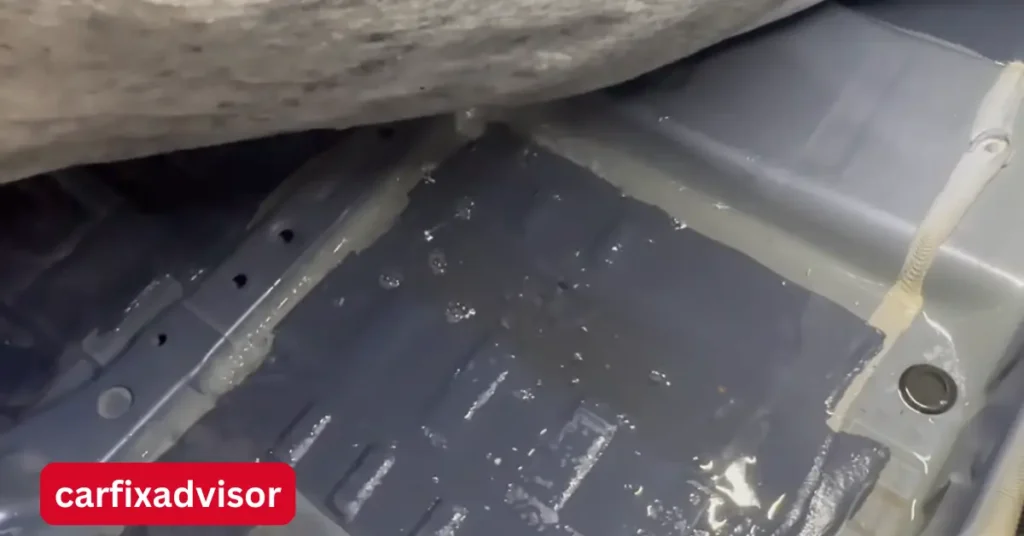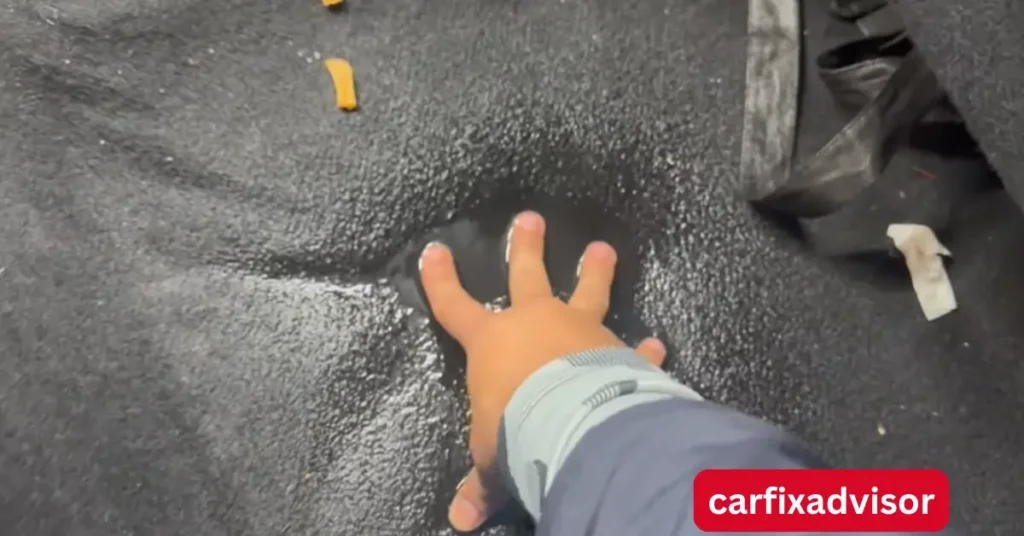A wet and smelly car carpet is not just unpleasant—it can cause mold, mildew, and interior damage. If my car carpet is wet and smells, it’s crucial to act fast. This guide will show you how to dry, clean, and deodorize your car carpet, plus tips to prevent future moisture problems.
Why is My Car Carpet Wet and Smelly?
Moisture Buildup in the Carpet
A wet and smelly carpet usually results from moisture trapped within the carpet and padding. This moisture may come from spills, rainwater entering through leaks, or high humidity. If left untreated, this moisture can cause the carpet to develop unpleasant odors and become a breeding ground for mold and mildew.
Mold and Mildew Growth
When moisture is left trapped in the carpet for extended periods, mold and mildew can start to grow. Not only does this contribute to the musty smell, but it can also cause damage to your car’s interior. Mold can spread to the padding underneath the carpet and may even affect other areas of the car if not addressed promptly.
Step-by-Step Guide to Drying Your Wet Car Carpet
Remove Floor Mats
The first thing you should do is remove any floor mats from your car. Mats are often made of materials that can hold moisture, and they should be dried separately. This will help speed up the drying process of your carpet.
Vacuuming Excess Moisture
Next, you need to remove as much standing water as possible. A wet/dry vacuum is perfect for this task. Use the vacuum to suck up water from the carpet and padding. This will help reduce the overall moisture and speed up the drying process. Be thorough but gentle to avoid damaging the carpet fibers.
Using Fans for Faster Drying
After vacuuming up the excess water, use fans to circulate air and dry out the carpet. Place fans inside the car, focusing on the wet areas. Make sure to leave the car doors open to promote airflow. If possible, use multiple fans to maximize the drying process. This will help prevent mold growth by reducing moisture as quickly as possible.
Moisture Absorbers
To help absorb any remaining moisture, consider using moisture-absorbing products like baking soda, kitty litter, or commercial moisture absorber bags. Place these products on the wet carpet and leave them for several hours or overnight to draw out excess moisture. Afterward, vacuum the products up, leaving your carpet drier and fresher.
Ventilation Tips
If weather permits, park your car in a well-ventilated area with the windows slightly open. Fresh air will help dry the carpet while also reducing the chance of mold and mildew forming. Make sure to avoid parking in areas where rain or high humidity might reintroduce moisture

Identifying and Fixing the Source of the Moisture
Checking for Leaks Around the Car
If your carpet is wet, the next step is to identify the source of the moisture. Start by inspecting your car for leaks. Check around the windows, doors, sunroof, and any other possible entry points for water. Look for wet spots on the carpet, particularly near the edges of the car, where water is more likely to seep in.
Inspecting Seals for Damage
Damaged or worn seals around the doors and windows could allow water to seep into the car during rain or when washing the vehicle. Check these seals for any visible damage, such as cracks, tears, or signs of wear. If you find any damaged seals, replacing them is a simple yet effective solution to prevent future leaks.
Inspecting Drains for Blockages
Another common cause of water leakage into the car is clogged drains. Check the AC evaporator drain and other body drains for leaves, dirt, or debris that could be blocking water flow. These blockages can cause water to back up and enter your car. Clear the drains to ensure proper water flow and prevent any future leaks.
Identifying Coolant Leaks
If the wetness is concentrated near the heater core (usually located under the dashboard on the passenger side), it could be a coolant leak. Coolant leaks are often accompanied by a sweet smell. If you suspect a coolant leak, it’s important to have it checked by a mechanic as it can cause significant damage to the engine and interior.
Deodorizing Your Car Carpet
Using Baking Soda to Absorb Odors
Baking soda is an excellent natural deodorizer. To eliminate the musty smell from your wet carpet, sprinkle a generous amount of baking soda over the affected areas. Let it sit for several hours or overnight to absorb the odors. Once done, simply vacuum the baking soda up, leaving your carpet smelling fresh.
Vinegar Solution for Odor Removal
A mixture of white vinegar and water can be effective at neutralizing bad odors. Mix equal parts white vinegar and water in a spray bottle, then spray the solution lightly over the carpet. Allow it to sit for a few minutes, then scrub and dry the carpet thoroughly. This solution helps combat mold and mildew smells while also freshening up your car’s interior.
Carpet Shampoo for Deeper Clean
If the odor persists, consider using a carpet shampoo specifically designed for odor removal. Follow the manufacturer’s instructions, and make sure to use a product that is safe for your car’s upholstery. Carpet shampoos can clean deep into the fibers and help eliminate stubborn smells from mold, mildew, or spilled liquids.
Using Enzyme Cleaners for Stubborn Odors
For more persistent odors, enzyme-based cleaners are an excellent option. These cleaners break down the organic compounds that cause smells, making them particularly effective against mold and mildew. Apply the enzyme cleaner to the affected areas and allow it to work before vacuuming up the residue.
Preventing Future Issues: How to Keep Your Car Carpet Dry and Fresh
Regular Interior Cleaning
Regularly vacuum and clean your car’s interior to prevent moisture and dirt buildup. This not only keeps your car looking clean but also reduces the chances of mold or mildew forming in your carpets. If you live in an area with high humidity or frequent rain, consider using a dehumidifier in your car.
Ensuring Proper Air Circulation
Make sure your car is well-ventilated, especially during wet weather. Leave the windows slightly open when parked (if the weather permits), and consider using moisture-absorbing products in the car during damp conditions. Proper airflow helps reduce humidity and moisture buildup inside the vehicle.
Addressing Leaks Immediately
If you notice any leaks, address them as soon as possible. Whether it’s replacing seals, unclogging drains, or fixing a coolant leak, timely repairs can save you from dealing with bigger problems later. Preventing water from entering your car is key to maintaining a dry and odor-free interior.
FAQs on My Car Carpet is Wet and Smells
Can I Use a Hair Dryer to Dry My Car Carpet?
While a hair dryer can be useful for drying small areas, it’s not the most efficient method. It’s best to use a wet/dry vacuum and fans to remove moisture more effectively. If using a hair dryer, be cautious not to overheat the carpet.
How Long Does It Take for a Wet Car Carpet to Dry?
Depending on the severity of the wetness and drying methods, it may take anywhere from a few hours to 24 hours for your car carpet to dry completely. Using fans and moisture absorbers can speed up the process.
What Are the Best Moisture Absorbers for Car Carpets?
Baking soda, kitty litter, and commercial moisture-absorbing bags are all great options for absorbing moisture from your car carpet. These products help draw out excess moisture and prevent mold growth.
How Can I Prevent Mold in My Car Carpet?
To prevent mold, keep your car dry by regularly cleaning the interior and ensuring proper ventilation. Use moisture-absorbing products when needed and address any leaks promptly.
Final thoughts: My Car Carpet is Wet and Smells
A wet and smelly car carpet can be a frustrating problem, but it’s one that can be easily fixed with a little effort. By drying the carpet thoroughly, identifying and fixing leaks, deodorizing the interior, and taking preventive measures, you can restore your car’s cleanliness and comfort. Regular maintenance is key to keeping your car carpet dry and fresh, ensuring that you avoid mold, mildew, and unpleasant odors in the future.

